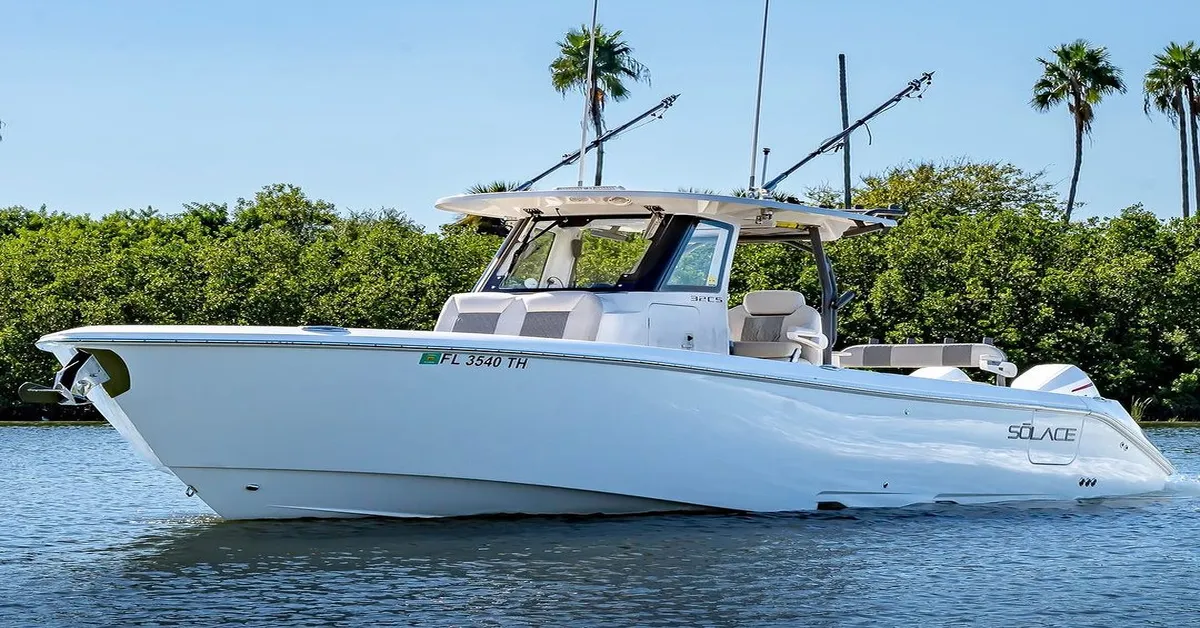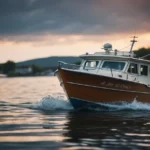If you’re looking for a thrilling way to explore the great outdoors, boating is an excellent option. However, if you’re new to the hobby, learning how to drive a boat can be intimidating. Luckily, we’re here to help you get started and become a confident boat operator in no time.
Safety should always be your top priority when driving a boat, so it’s crucial to understand the power of the water and be aware of your surroundings at all times. But don’t worry, with practice and some basic guidelines, driving a boat can become second nature.
This article will provide tips and techniques to help you develop the skills necessary for a safe and enjoyable boating experience. From maneuvering through tight spaces to handling open water conditions, we’ll take you step-by-step through the basics of how to drive a boat. So, let’s dive in and get started!
Understanding the Basics
We know you’re excited to learn how to drive a boat, and understanding the basics is an essential first step. In this section, we’ll cover fundamental knowledge every boater should have, specifically about boat types and control. This will help you become familiar with your vessel and how it operates.
Know Your Boat

Before heading out on the water, it’s crucial to familiarize yourself with the type of boat you’ll be operating. Various boats have unique characteristics and handling, such as motorboats, pontoon boats, sailboats, and inboard and outboard-powered boats.
Motorboats and pontoon boats are typically driven using a steering wheel, throttle, and brakes. On the other hand, sailboats require a deeper understanding of wind and sails to maneuver efficiently.
When it comes to engines, boats can be powered by either an inboard engine or an outboard engine. Inboard boats have the engine and propulsion system built into the hull, while outboard boats have a detachable engine mounted on the transom.
Boat Controls

Now that you’re familiar with different boat types let’s discuss the critical controls you’ll need to operate while boating:
- Steering Wheel: This allows you to steer the boat in the desired direction. In most boats, turning the wheel clockwise steers the boat to starboard (right), while turning it counterclockwise steers it to port (left).
- Throttle: Controls the engine’s speed and is usually located near the steering wheel. The throttle handle is typically pushed forward to increase speed and pulled back to decrease speed or shift into reverse.
- Throttle Control: Adjust the throttle position to maintain a steady course when driving and docking your boat.
- Trim Tabs: These are adjustable plates on the hull that help balance the boat’s performance. Adjusting trim tabs can improve speed, fuel efficiency, and ride stability.
- Kill Switch: A safety device designed to shut off the boat’s engine in case of an emergency. The kill switch is connected to the boat operator via a lanyard to ensure that the engine stops if the operator is thrown from the boat or encounters other issues.
- Tiller: Primarily found on small boats, the tiller is a lever used to steer by altering the angle of the rudder or outboard motor.
Lastly, there are various types of boat ignition systems, including push-button ignition, key ignition, and RFID fob ignition, depending on the boat model. Familiarize yourself with the ignition system of your boat to ensure smooth operation.
Now that you have a good understanding of the basics, you’ll be better prepared to take on the rewarding challenge of learning how to drive a boat. Stay focused, practice, and enjoy your time on the water!
Safety Precautions

Learning how to drive a boat is an exciting and fun experience, but it’s essential always to prioritize safety. In this section, we’ll outline key safety precautions and tips to keep in mind when you’re out on the water.
By carefully following these steps and taking necessary precautions, you can enjoy your time on the water and make your boating experience safe and enjoyable.
Pre-Departure Checklist
Before you start your boating adventure, there are several essential steps to take and items to check. Here’s a pre-departure checklist:
- Safety equipment: Make sure you have all the necessary safety equipment on board, including life jackets for all passengers, a first aid kit, flares, a fire extinguisher, and a sound-signaling device.
- Life jackets: Ensure that all passengers are wearing appropriate life jackets while the boat is in motion.
- Engine compartment: Inspect the engine compartment and ensure it’s clean, well-ventilated, and free of any fuel or oil leaks.
- Blower: Operate the blower for at least four minutes to remove any gasoline fumes before starting the engine.
- Fuel: Be sure you have enough fuel for your trip and an extra supply as a precaution.
- Mooring lines: Check all mooring lines and ensure that they’re in good condition, and properly stow them after casting off.
Boating Safety
You should also take steps to improve your knowledge and skills in boating safety:
- Boating safety course: If you’re a new boat owner or unfamiliar with boating safety rules, completing a boating safety course is a good idea. Many safety courses can be taken online or at registered training centers.
- Safe speed and lookout: While operating your boat, it is crucial to maintain a safe speed and a proper lookout to avoid accidents. Be aware of your surroundings, other boats, and changes in weather conditions.
- Boat safety kit: Your boat safety kit should always be on board. This kit can help you respond to unexpected emergencies and ensure the safety of everyone onboard.
By carefully following these steps and taking necessary precautions, you can enjoy your time on the water and make your boating experience safe and enjoyable.
Starting and Stopping the Boat

Learning how to drive a boat involves various steps, but one of the most important aspects to master is starting and stopping the boat. We will cover ignition, starting, and stopping your boat in this section to ensure a smooth and safe boating experience.
Starting the Boat
Before starting a boat, make sure the engine’s kill switch is attached, as it is an essential safety feature. To begin, follow these simple steps:
- Insert the key into the ignition.
- Turn the key to activate the boat’s engine.
- Listen for the engine to start running.
- Check for any unusual sounds or indications that something might not be working properly.
Remember to always give your boat a thorough inspection before setting off, ensuring all systems are functioning correctly.
Stopping the Boat
When it comes to stopping your boat, there are a couple of methods to employ, depending on the circumstances:
- Slow down: Gradually reduce the throttle, allowing the boat’s speed to decrease until you completely stop.
- Stop in an emergency: In urgent situations, quickly move the throttle to neutral and firmly engage the stop button or kill switch.
It’s essential to practice both methods in different conditions to become proficient in operating the boat safely. Additionally, consider upcoming waves, wind, and water currents when decelerating, as they can have significant effects on your boat’s ability to stop smoothly.
By mastering starting and stopping the boat, you’ll be well on your way to becoming a proficient boater and enjoying your time on the water safely.
Boat Maneuvers

Driving a boat can be an exciting and rewarding experience, but it’s essential to know the basics before setting off on the water. This section will cover essential boat maneuvers to help you safely and confidently steer, dock, and trim your boat. Let’s dive in and learn how to drive a boat like a pro!
Steering a Boat
Navigating a boat starts with understanding how to properly steer it. The steering wheel on a boat works similarly to that of a car, with turning the wheel to the right directing the boat to the right and vice versa.
It’s crucial to maintain a good lookout of your surroundings and to adjust your speed accordingly. Slow is pro – take your time to familiarize yourself with the boat’s handling and responsiveness.
Docking and Mooring
Docking and mooring present unique challenges, especially for beginners. Initially, approach the dock or mooring site at a slow, controlled speed, and be prepared to adjust your approach based on changing conditions like wind and currents.
Make sure the boat is positioned at a 45-degree angle to the dock, and have a crew member secure the mooring lines once it’s safe.
In tight spaces, shifting into neutral for more precise handling is essential. Twin-engine boats may demand a slightly altered approach, such as aligning the steering wheel at the center and controlling the boat using the throttles.
Trimming a Boat
Trimming a boat involves adjusting the boat’s angle in the water to maximize stability and performance. This can be achieved through trim tabs or by redistributing the weight on the boat.
An improperly trimmed boat may cause inefficient fuel consumption, uncomfortable rides, or difficulty steering. To correctly trim a boat, first, determine the proper angle at which the boat should be cruising.
Then, adjust the trim tabs or redistribute the weight to achieve this angle. It’s crucial to continuously monitor your boat’s performance and make adjustments accordingly. Keep in mind that changing conditions may require you to adjust your boat’s trim to maintain optimal stability and performance.
Now that you’ve learned the basics of boat maneuvers, you can confidently steer, dock, and trim your boat while enjoying your time on the water.
Now that you’ve learned the basics of boat maneuvers, you can confidently steer, dock, and trim your boat while enjoying your time on the water.
Understanding Weather and Water Conditions

When learning how to drive a boat, it’s crucial that we understand how weather and water conditions impact boat handling and safety. In this section, we’ll delve into reading the weather, navigating waves, and understanding currents.
Reading the Weather
Being able to accurately assess weather conditions is a critical aspect of responsible boating. As we encounter dense fog, strong winds, or sudden storms, knowing how to react is essential.
First, always check marine weather forecasts before heading out on the water. Keep an eye on wind patterns, as a clockwise wind direction change often signals fair weather ahead, while a counterclockwise change indicates worsening conditions.
Navigating Waves
Managing waves while out on the water is a vital skill we must acquire. A boat’s hull type significantly affects its reaction to waves and riding comfort. Large waves and high winds can make navigation challenging, so it’s important to proceed with caution.
Reducing speed and heading into waves at a slight angle can help us maintain control and prevent the boat from capsizing or being swamped by breaking waves.
Understanding Currents
Currents have a profound influence on boat handling and safety. To successfully navigate through currents, we need to consider the boat’s hull type, as it largely determines the vessel’s reaction to the water’s flow.
Monitoring the current and adjusting our speed and heading is essential to maintain control and ensure we reach our intended destination safely.
By understanding weather and water conditions, we can make informed decisions and keep ourselves and our passengers safe while driving a boat.
Advanced Boat Driving

Learning how to drive a boat is an exciting adventure, and once you’ve mastered the basics, it’s time to explore some advanced techniques. In this section, we’ll dive into driving different types of boats, navigating, launching, reversing, and accelerating. Let’s go!
Driving Different Types of Boats
Driving various boats, such as motorboats, powerboats, and twin-engine boats, requires different skill sets. For instance, motorboats typically have a single inboard or outboard engine, making maneuvering easier.
On the other hand, twin-engine boats offer more precision when turning and docking but require additional practice to coordinate the engines.
In order to become proficient at driving different types of boats, it’s crucial to familiarize yourself with their unique controls, throttles, and steering mechanisms. Research each boat’s specifications and seek hands-on training to build your skills effectively.
Navigating a Boat
Mastering navigation will not only enhance your boat driving experience but also ensure your safety on the water. Here are a few essential aspects of boat navigation:
- Understanding Charts: Get comfortable with nautical charts, which display water depths, navigational aids, and potential hazards.
- Using Marine Electronics: Equip your boat with GPS devices and other marine electronics to obtain accurate location, speed, and route information.
- Maintaining a Proper Lookout: Always monitor your surroundings, looking for other boats, buoys, and obstacles.
Launching a Boat
Launching a boat can be intimidating, but with practice and attention to detail, you’ll soon become an expert. Follow these steps:
- Prepare the boat: Remove any straps and covers, and ensure the drain plug is securely in place.
- Back up the trailer: Carefully reverse your vehicle, aligning the boat with the water’s edge.
- Release the boat: Unhook the bow and ensure any necessary safety equipment is on board.
- Launch: Gently lower the boat into the water, using an assistant to maintain control.
Reversing a Boat
Reversing a boat demands attention and precision. Keep these tips in mind:
- Throttle control is critical. Gradually increase throttle, but be prepared to shift into neutral if needed.
- Turn the steering wheel in the direction you want the stern of the boat to go.
- Be mindful of water currents and wind direction, as they may affect the boat’s trajectory.
Accelerating
Smooth acceleration and throttle management are crucial when driving a boat. Some key points to remember include:
- Gradually apply throttle to avoid sudden jolts or overloading the engine.
- As the boat gains speed, adjust your trim or trim tabs for optimal performance and fuel efficiency.
- Monitor your surroundings to ensure a safe speed, considering factors like visibility and traffic.
With practice and determination, you’ll become a skilled advanced boat driver, ready to explore the open waters with confidence. Embrace the learning process and enjoy the exciting world of boating!
Additional Information

When learning how to drive a boat, it’s important to be well informed to ensure a safe and enjoyable experience. In this section, we’ll cover two key aspects that every boater should be aware of: Boater Education and Understanding Speed Limits.
Boater Education
Before hitting the water, taking a boater education course is a great idea, as it can provide essential tips and skills for maneuvering and operating your boat safely. A boating safety course can cover navigation rules, emergency procedures, and responsible boating practices.
Completing a boater education course not only enhances your boating knowledge but may also qualify you for discounts on boat insurance or fulfill certain state requirements.
Understanding Speed Limits
While there might not be clearly marked speed limits like on the road, it’s crucial for boaters to maintain a safe speed while on the water. Safe speed refers to the ability to stop and avoid collisions or any other potential hazards in the given conditions. The speed should be adjusted based on factors such as:
- Weather conditions
- Visibility
- Traffic around your watercraft
Keep in mind that some waterways might have specific speed limits in place to protect the environment or ensure boater safety. Be sure to familiarize yourself with local and state regulations before setting out on your boating adventure.
By adhering to the rules and being responsible, you’ll ensure a pleasant and safe experience for yourself and others on the water.
Our 5 Best Tips to Learn How To Drive a Boat
- Take a boating safety course to learn the basics of boating and safety regulations.
- Familiarize yourself with the boat’s controls, including the steering wheel, throttle, and gear shift.
- Practice maneuvering the boat in open water and tight spaces to build confidence and improve your skills.
- Learn how to read the water and understand how wind, waves, and currents affect your boat’s movement.
- Follow local laws and regulations and practice good boating etiquette to ensure a safe and enjoyable experience for everyone on the water.
Learning how to drive a boat can be exciting and challenging. In this section, we will discuss some frequently asked questions regarding how to drive a boat. We hope this helps to clarify your concerns and makes the process of learning more enjoyable.
FAQ – How to Drive a Boat
Is it easy to ride a boat?
Yes, it can be easy to ride a boat, especially if you have prior experience with driving other vehicles or have received proper guidance. However, it’s essential to practice and be familiar with your boat’s controls and navigation systems. Additionally, keep in mind that different types of boats may vary in difficulty to operate.
Do you drive or steer a boat?
Both terms are used when controlling a boat. Steering refers to directing the boat in the desired direction using the wheel, rudder, or tiller. Driving, on the other hand, encompasses the entire process of operating a boat, including controlling speed, steering, and using the boat’s various systems.
What is the easiest boat to drive?
The easiest boats to drive are small, entry-level, and often powered by outboard motors. Examples include runabouts, bowriders, and pontoon boats. These boats usually have simple controls and are quite manageable for beginners. However, remember that no matter the boat’s size, proper understanding of navigation rules and safety precautions is crucial.
What do I need to know before boating?
Before setting out on the water, there are several things you should consider:
Safety: Equip your boat with life jackets, flares, a first-aid kit, and a working VHF radio.
Navigation rules: Understand the rules of the water, such as right-of-way and signage.
Weather conditions: Check the weather forecast and plan accordingly.
Boat systems: Familiarize yourself with your boat’s controls, steering mechanism, and any other essential systems.
Pre-departure checklist: Ensure that your boat is in good condition and you have all necessary supplies.
Why are boats right-hand drive?
While not all boats are right-hand drive, many are designed this way due to the propeller’s rotation. In a clockwise rotating propeller, the boat tends to turn to the right, making it easier to steer on the right side.
Additionally, the standard international navigation rules dictate that when two vessels encounter each other head-on, each should steer to its respective right, aligning with the right-hand drive configuration.
After reading our article, we hope you know how to drive a Boat & We look forward to your comments below – Let us know what you think!





